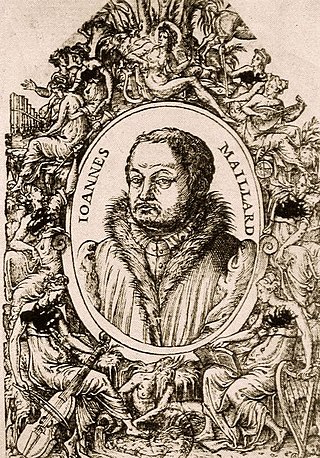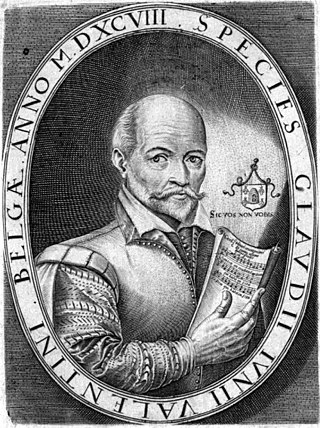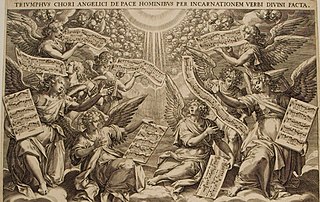Related Research Articles
Jacobus Clemens non Papa was a Netherlandish composer of the Renaissance based for most of his life in Flanders. He was a prolific composer in many of the current styles, and was especially famous for his polyphonic settings of the psalms in Dutch known as the Souterliedekens.
Antoine Brumel was a French composer. He was one of the first renowned French members of the Franco-Flemish school of the Renaissance, and, after Josquin des Prez, was one of the most influential composers of his generation.
A chanson is generally any lyric-driven French song. The term is most commonly used in English to refer either to the secular polyphonic French songs of late medieval and Renaissance music or to a specific style of French pop music which emerged in the 1950s and 1960s. The genre had origins in the monophonic songs of troubadours and trouvères, though the only polyphonic precedents were 16 works by Adam de la Halle and one by Jehan de Lescurel. Not until the ars nova composer Guillaume de Machaut did any composer write a significant number of polyphonic chansons.
Jacques Arcadelt was a Franco-Flemish composer of the Renaissance, active in both Italy and France, and principally known as a composer of secular vocal music. Although he also wrote sacred vocal music, he was one of the most famous of the early composers of madrigals; his first book of madrigals, published within a decade of the appearance of the earliest examples of the form, was the most widely printed collection of madrigals of the entire era. In addition to his work as a madrigalist, and distinguishing him from the other prominent early composers of madrigals – Philippe Verdelot and Costanzo Festa – he was equally prolific and adept at composing chansons, particularly late in his career when he lived in Paris.
Nicolas Gombert was a Franco-Flemish composer of the Renaissance. He was one of the most famous and influential composers between Josquin des Prez and Palestrina, and best represents the fully developed, complex polyphonic style of this period in music history.
Antoine de Févin was a Franco-Flemish composer of the Renaissance. He was active at the same time as Josquin des Prez, and shares many traits with his more famous contemporary.
Gaspar van Weerbeke was a Netherlandish composer of the Renaissance. He was of the same generation as Josquin des Prez, but unique in his blending of the contemporary Italian style with the older Burgundian style of Dufay.
Pierre Certon was a French composer of the Renaissance. He was a representative of the generation after Josquin and Mouton, and was influential in the late development of the French chanson.

Jean Maillard was a French composer of the Renaissance.

Claude Le Jeune was a Franco-Flemish composer of the late Renaissance. He was the primary representative of the musical movement known as musique mesurée, and a significant composer of the "Parisian" chanson, the predominant secular form in France in the latter half of the 16th century. His fame was widespread in Europe, and he ranks as one of the most influential composers of the time.
France has a rich music history that was already prominent in Europe as far back as the 10th century. French music originated as a unified style in medieval times, focusing around the Notre-Dame school of composers. This group developed the motet, a specific musical composition. Notable in the high Middle Ages were the troubadours and trouvères soon began touring France, composing and performing many original songs. The styles of ars nova and ars subtilior sprung up in the 14th century, both of which focused on secular songs. As Europe moved into the Renaissance age, the music of France evolved in sophistication. The popularity of French music in the rest of Europe declined slightly, yet the popular chanson and the old motet were further developed during this time. The epicenter of French music moved from Paris to Burgundy, as it followed the Burgundian School of composers. During the Baroque period, music was simplified and restricted due to Calvinist influence. The air de cour then became the primary style of French music, as it was secular and preferred by the royal court.

Guillaume Costeley [pronounced Cotelay] was a French composer of the Renaissance. He was the court organist to Charles IX of France and famous for his numerous chansons, which were representative of the late development of the form; his work in this regard was part of the early development of the style known as musique mesurée. He was also one of very few 16th century French composers of music for keyboard. In addition, he was a founding member of the Académie de Poésie et de Musique along with poet Jean-Antoine de Baïf, and he was one of the earliest composers to experiment with microtonal composition.
Claudin de Sermisy was a French composer of the Renaissance. Along with Clément Janequin he was one of the most renowned composers of French chansons in the early 16th century; in addition he was a significant composer of sacred music. His music was both influential on, and influenced by, contemporary Italian styles.
Jacobus Vaet was a Flemish composer of the Renaissance. He was a representative of the generation between Josquin and Palestrina, writing smooth polyphony with pervasive imitation, and he was a friend both of Clemens non Papa and Lassus.
Antoine de Bertrand was a French composer of the Renaissance. Early in his life he was a prolific composer of secular chansons, and late in his life he wrote hymns and canticles, under the influence of the Jesuits. He was murdered by Protestants during the French Wars of Religion.

Andreas Pevernage or Andries Pevernage was a Flemish composer of the late Renaissance and a choirmaster in Bruges, Kortrijk, and Antwerp. He was one of a few composers from the Low Countries who remained in his native land throughout the turbulent period of religious conflict in the late 16th century. He was a skilled composer of chansons, motets and madrigals.
This is a list of notable events in music that took place in 1555.
Benedictus Appenzeller was a Franco-Flemish singer and composer of the Renaissance, active in Bruges and Brussels. He served Dowager Queen Mary of Hungary for much of his career, and was a prolific composer of vocal music, both sacred and secular, throughout his long career.
Pierre Cadéac was a French composer and probably singer of the Renaissance, active in Gascony. He wrote both sacred and secular vocal music, and had his music published in Paris and Lyons. His most famous work was the chanson Je suis deshéritée, which many later composers, including Lassus and Palestrina, used as a basis for parody masses.
Cornelius Canis was a Franco-Flemish composer, singer, and choir director of the Renaissance, active for much of his life in the Grande Chapelle, the imperial Habsburg music establishment during the reign of Emperor Charles V. He brought the compositional style of the mid-16th century Franco-Flemish school, with its elaborate imitative polyphony, together with the lightness and clarity of the Parisian chanson, and he was one of the few composers of the time to write chansons in both the French and Franco-Flemish idioms.
References
- Howard Mayer Brown: "Chanson, 4." The New Grove Dictionary of Music and Musicians, ed. Stanley Sadie. 20 vol. London, Macmillan Publishers Ltd., 1980. ISBN 1-56159-174-2
- Frank Dobbins: "Pierre Cadéac", Grove Music Online, ed. L. Macy (Accessed July 20, 2007), (subscription access)
- Reese, Gustave (1954). Music in the Renaissance . W. W. Norton & Co. ISBN 978-0-393-09530-2.